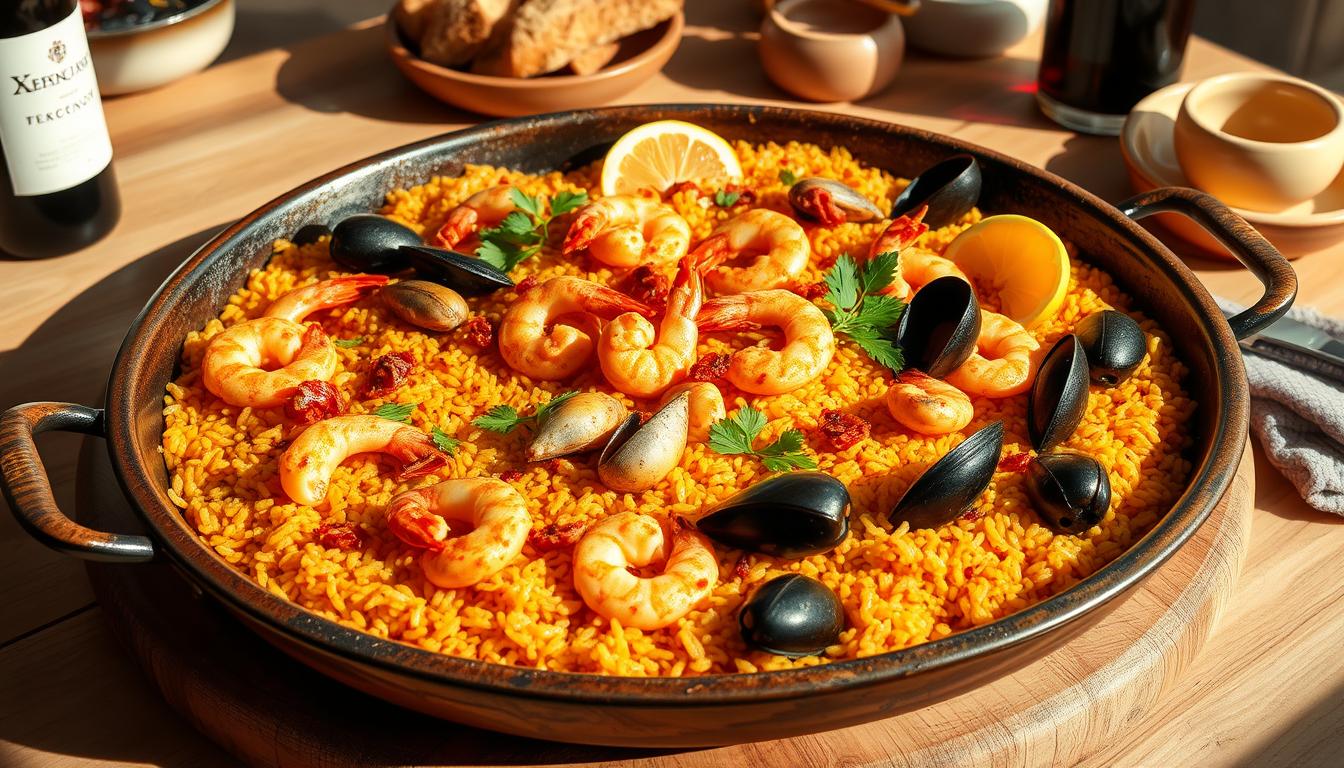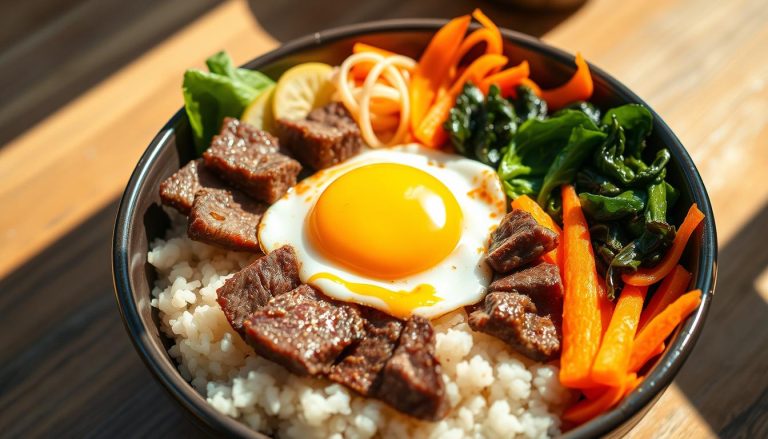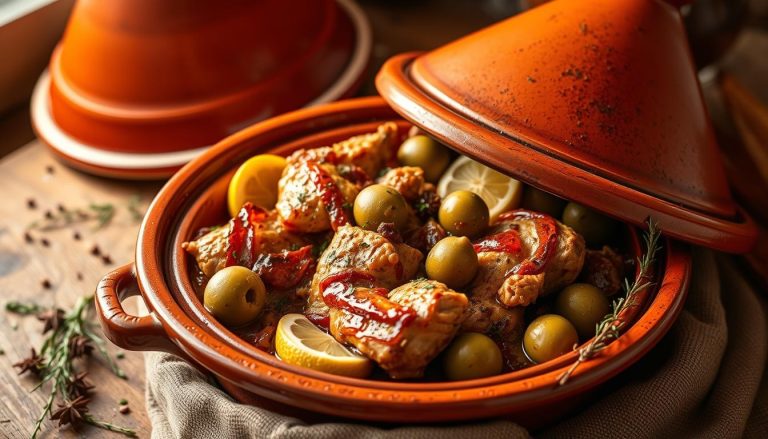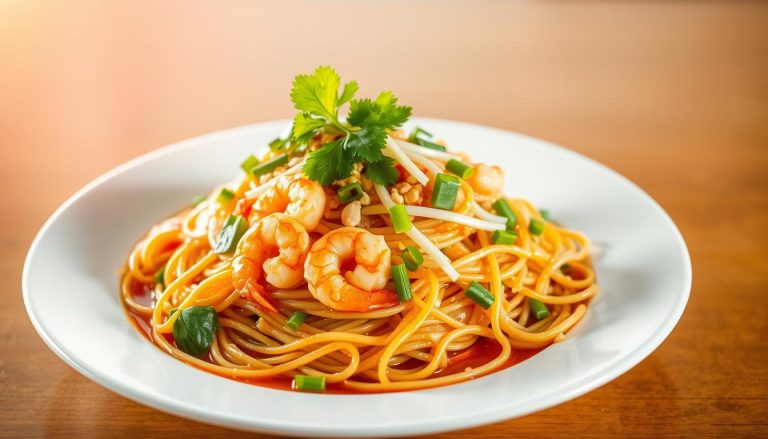Savor the Flavors of Spain: Authentic Seafood Paella
Imagine the sun-kissed plains of Valencia, where the best spanish paella dish was born. Authentic spanish paella with seafood & saffron carries centuries of tradition. It blends the Mediterranean’s bounty into one vibrant dish. Each grain of rice, infused with saffron’s golden hue, tells a story of Spain’s culinary soul.
This article unlocks the secrets behind this iconic meal. It explores its history, key ingredients like bomba rice, and the techniques that separate true paella from imitations. Learn how to recreate the crispy socarrat crust and the harmony of fresh seafood flavors at home.
Key Takeaways
- Authentic paella originates from Valencia, highlighting regional ingredients and tradition.
- Saffron is essential for the signature flavor and color of authentic spanish paella with seafood & saffron.
- Mastering rice texture and timing ensures a dish as close as possible to Spain’s best paella recipes.
- Seafood paella combines shrimp, mussels, and monkfish for a true coastal flavor profile.
- Proper pan selection and cooking technique create the prized socarrat layer.
The Rich Heritage of Spanish Paella
Paella is a dish with a rich history in Spanish cuisine. It was born in Valencia’s sunny plains and has become a global favorite. Yet, it remains deeply rooted in Spanish culture.
Origins in Valencia: The Birthplace of Paella
Paella started with 18th-century farmers in Valencia. They cooked rice, saffron, and local meats like rabbit and snails. The name “paella” comes from the Valencian word for the cooking pan.
This simple meal became a symbol of using what the land gives. It showed the resourcefulness of the farmers.
From Countryside to Coast: The Evolution of Seafood Paella
As paella spread, coastal areas added seafood. This created the valencia-style seafood paella we love today. By the 19th century, it was a hit at festivals.
Key changes include:
- Rural origins: Rabbit, beans, artichokes
- Coastal twist: Shrimp, mussels, and squid
- Modern twists: Global chefs’ creative takes
Cultural Significance in Spanish Cuisine
Paella is more than just food in Spain. It’s a key part of paella parties at weddings and fiestas. Valencians are proud of their recipes, passed down through generations.
The dish’s communal cooking strengthens family ties and regional pride.
| Tradition | Symbolism |
|---|---|
| Family gatherings | Unity and celebration |
| Seasonal ingredients | Connection to land and sea |
Essential Ingredients for an Authentic Seafood Paella
The key to a great paella is using top-notch ingredients. Each part adds to the dish’s flavor balance. Let’s dive into what makes this recipe stand out.
Selecting the Perfect Rice: Bomba vs. Alternatives
Bomba rice, from Valencia, absorbs liquid well without getting soggy. If you can’t find Bomba, Calasparra or Arborio are good substitutes. Choose short-grain rice to prevent dryness.
The Magic of Saffron: Why It’s Worth the Splurge
- Use premium saffron threads for intense flavor—grind them first for even distribution.
- A pinch goes a long way in saffron-infused paella. Avoid powdered blends for authentic color and taste.
Seafood Selection Guide: Shrimp, Mussels, and Beyond
Freshness is key. For spanish paella with shrimp and mussels:
| Ingredient | Tip |
|---|---|
| Shrimp | Pick firm, uncooked tails for best texture. |
| Mussels | Discard any that don’t close when tapped. |
| Clams/Squid | Add towards the end to prevent overcooking. |
The Sofrito Base: Building Layers of Flavor
A good sofrito starts with sautéed onions, garlic, and tomatoes. Cook them slowly to soften their flavors. Add red pepper for sweetness and bay leaves for depth.
Choose each ingredient carefully—each one builds on the last. From saffron’s golden threads to the briny mussels, every choice matters.
Traditional Tools and Equipment for Perfect Paella
Mastering authentic seafood paella is more than just ingredients. It’s about using the right tools. At the heart of this dish is the paellera, a wide, shallow pan for even cooking. This iconic skillet, often made of carbon steel, helps create the prized socarrat crust.
Choosing the right material is key. Carbon steel heats evenly and gets a non-stick surface over time. Stainless steel is easy to clean but might not sear as well. Enameled cast iron keeps heat but can be heavy for home use. See the comparison in the table below:
| Material | Pros | Cons |
|---|---|---|
| Carbon Steel | Even heating, develops patina | Requires seasoning |
| Stainless Steel | Durable, easy to clean | Less ideal for socarrat |
| Enameled Cast Iron | Heat retention, non-reactive | Heavy and slow to preheat |
Use a wooden spoon for stirring and a perforated rack for draining seafood. Traditionalists prefer open flame, but modern cooks can use gas burners or stovetops. For home cooks, a large griddle or oven-safe skillet can substitute.
For carbon steel pans, season them often. Don’t soak them in water. Stainless steel pans clean up with soap and a soft sponge. Cast iron pans need oil after washing. These tools are more than gadgets; they’re keys to the authentic seafood paella experience.
Step-by-Step: Authentic Spanish Paella with Seafood & Saffron
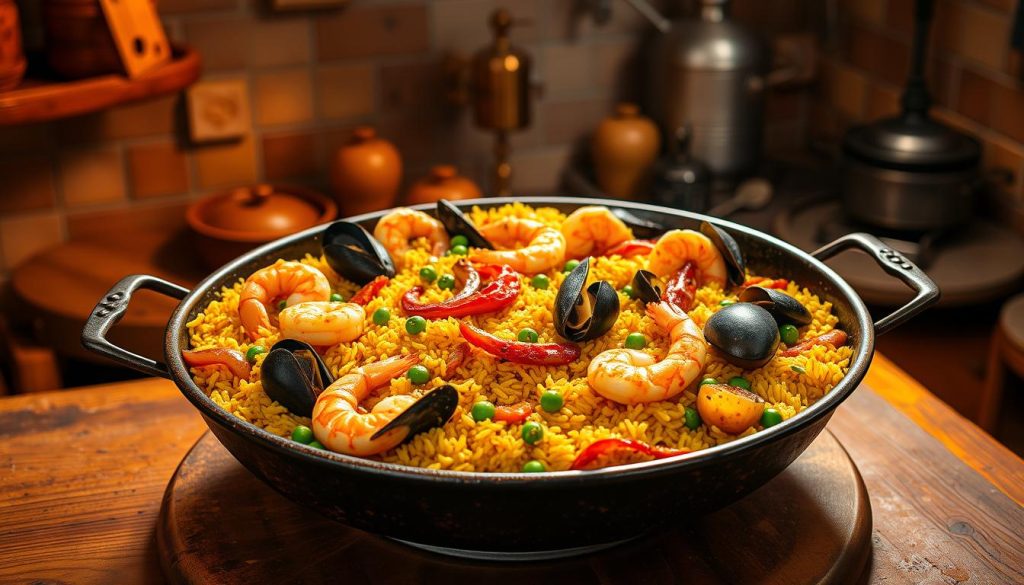
Learning to make seafood and saffron paella recipe is all about getting your hands dirty. Here’s how to make the authentic spanish paella with seafood & saffron in your own kitchen:
Preparing Your Seafood for Maximum Flavor
- Pat-dry shrimp, mussels, and clams with a clean towel.
- Peel and devein large shrimp; leave small ones whole for texture contrast.
- Pre-cook mussels in white wine for 2-3 minutes to open—discard any that stay closed.
Creating the Perfect Sofrito Foundation
Start by heating olive oil in a paella pan. Cook diced onions, garlic, and tomatoes on medium-low until they’re soft. Add paprika and let it simmer until it turns golden. This sweet, fragrant base is the heart of your dish.
The Art of Adding Rice and Saffron
Toast uncooked Bomba rice in the sofrito for 2 minutes. Add saffron threads and stir until the grains shine. Pour in 3 cups of seafood stock for every 1 cup of rice. Bring to a boil, then lower the heat.
| Rice | Stock | Cooking Time |
|---|---|---|
| 1 cup | 3 cups | 18-20 mins |
Achieving Socarrat: The Prized Crispy Bottom Layer
Cover the pan with foil after 15 minutes. Remove the foil in the last 5 minutes to let the crust form. Let the paella rest for 5 minutes after cooking. This is when the socarrat gets its best crispiness.
“The crust is the soul of paella—don’t stir, let it caramelize.” — Valencia chef Maria Gómez
Look for steam and rice soaking up the liquid. Take it off the heat when the rice is tender but a bit firm (al dente).
Common Mistakes to Avoid When Making Seafood Paella
Mastering the authentic seafood paella is more than just about the ingredients. It’s about the technique. Let’s look at the top mistakes that can ruin your dish.
Stirring the Rice: The Cardinal Sin of Paella Making
Don’t stir the rice! Unlike risotto, paella rice needs to stay put to get that crusty socarrat. Stirring can make the rice mushy. Instead, use a spatula to gently spread the rice without stirring.
- Spread ingredients evenly with a spatula, not a spoon.
- Let the rice rest undisturbed once added.
Liquid Ratios: Finding the Perfect Balance
The right amount of liquid is key. A classic seafood paella recipe calls for 3 cups of liquid for every cup of rice. Getting this wrong can mess up the texture.
| Rice | Liquid | Notes |
|---|---|---|
| 1 cup Bomba rice | 3 cups broth/water | Adjust by ¼ cup for high altitude |
Timing Your Seafood Additions
Don’t overcook the seafood. Add tougher items like mussels first, then shrimp last for 5 minutes. Quick-cooking squid should go in last, for at least 3+ minutes to avoid it becoming rubbery.
Cooking paella is a journey, not a race. These tips can help even seasoned chefs avoid common mistakes. Keep these in mind for your next authentic seafood paella masterpiece!
Valencia-Style Seafood Paella vs. Tourist Versions
Travelers often face a dilemma when ordering paella abroad. They must choose between 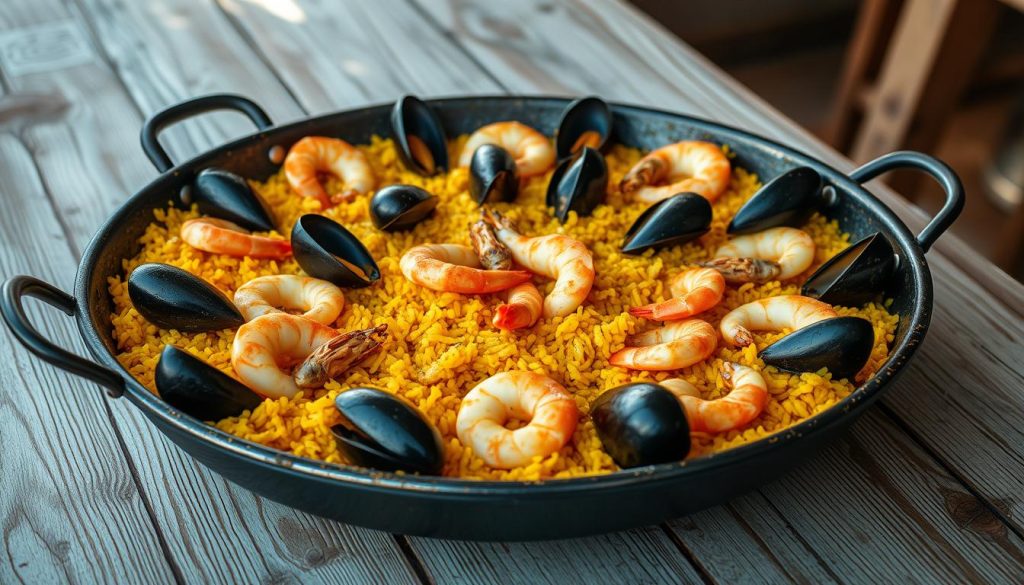 and commercial versions. The authentic version focuses on simplicity and local ingredients. Yet, many tourist versions add global twists.
and commercial versions. The authentic version focuses on simplicity and local ingredients. Yet, many tourist versions add global twists.
| Aspect | Authentic Valencia-Style | Tourist Adaptations |
|---|---|---|
| Seafood | Local mussels, shrimp, and clams | King prawns, squid, or lobster |
| Rice | Bomba rice from Valencia | Any short-grain rice |
| Saffron | Pure Spanish saffron threads | Artificial coloring |
| Serving | Shared from one pan | Individual portions |
Valencian chefs say valencia-style seafood paella doesn’t include chorizo or chicken. These are common in land-based paella but rare in seafood versions. A local chef once said,
“Authenticity isn’t about strict rules—it’s about honoring regional roots.”
In Spain’s coastal regions, tourist spots often add coconut milk or pineapple. This changes the dish’s heritage. To find the real thing, look for menus with paella de mariscos and minimal additives. Enjoying it in Valencia or making it at home, respecting tradition and creativity keeps this dish alive.
Wine Pairings That Complement Your Seafood and Saffron Paella
Choosing the right wine can make your paella meal unforgettable. The saffron in the paella adds a unique flavor. You want a wine that brings out the dish’s freshness without being too strong.
Bright whites with a bit of acidity and minerality work well. They balance the seafood’s saltiness and the rice’s saffron taste.
Go for crisp whites that remind you of the sea:
| Wine Type | Producer Example | Flavor Profile | Serving Temp (°F) |
|---|---|---|---|
| Albariño | Pazo de Señorán | Crisp citrus, saline minerals | 45-50 |
| Verdejo | Viña Coste | Green apple, almond, herbal zest | 48-52 |
| Cava | Gramona | Apple-citrus sparkle, toasted brioche | 45-50 |
Choose wines from the same region as your paella:
- Rías Baixas Albariño with shellfish-rich paella
- Rueda Verdejo for saffron-infused paella’s herbal notes
- Valencian Cava as a celebratory match
For something different, try Basque Country’s txakoli. It’s fizzy and salty, just like the sea. Chill your wine a bit to cool your palate between bites.
Serving Traditions and Presentation Tips
Sharing a traditional spanish rice dish like paella is more than just eating. In Spain, paella with shrimp and mussels is served straight from the pan. This makes the meal a lively, shared experience. Use a paellera stand to keep it warm, inviting everyone to serve themselves.
This way, the rice stays crispy, and everyone gets to enjoy the socarrat layer at the bottom.
- Designate “zones”: Divide the pan into sections for seafood lovers and rice purists to personalize their portions.
- Accompany with freshness: Offer lemon wedges, chopped parsley, and a drizzle of olive oil for guests to customize their servings.
- Serve with simplicity: Pair the dish with crusty bread, a crisp Spanish salad, or a handful of marinated olives to balance the meal.
For presentation, arrange the spanish paella with shrimp and mussels so the seafood clusters remain intact near the edges. Serve lemon wedges in a small bowl and aioli in ramekins. Take photos before serving—the golden rice, vibrant seafood, and smoky aroma make stunning visuals. Timing is key: ensure sides like roasted vegetables or gazpacho are ready as the paella finishes cooking.
Embrace the spirit of sharing—this traditional spanish rice dish shines when enjoyed together. Whether at a dinner party or a casual gathering, the communal ritual transforms the meal into a celebration of Spanish tradition.
Adapting Authentic Paella for American Kitchens
Making the classic seafood paella recipe at home is easy. Start by using calasparra rice or arborio instead of bomba rice. For the golden color, use saffron threads or a good saffron substitute.
- Equipment hacks: Use a large skillet or cast-iron pan instead of a paellera. A grill-safe skillet works for outdoor cooking.
- Ingredient swaps: Substitute mussels with clams or scallops. Fresh shrimp and calamari add authenticity without exotic sourcing.
- Portion adjustments: Double the recipe for gatherings, but avoid overcrowding the pan. Cook in batches if needed.
American kitchens often lack paella burners, but stovetop cooking works. Add 1.5 cups broth per cup of rice, simmer until liquid is absorbed, then finish with a 5-minute high-heat burst for socarrat. For shellfish allergies, swap seafood for roasted bell peppers or artichokes—keeping the best spanish paella dish spirit alive. Prep veggies and seafood ahead to save time. A quote from chef Juan Sánchez: “The soul of paella is balance, not perfection.”
Experiment with local ingredients while respecting tradition. A gluten-free version needs only rice substitution, and pescatarian tweaks are effortless. With these tips, every home cook can serve a dish that honors its roots while fitting modern American kitchens.
Conclusion: Bringing Spain to Your Table Through Paella
Authentic paella is more than a meal; it’s a gateway to traditional spanish cuisine. The golden saffron and crispy crust tell stories of Spain’s rich food history. Cooking this dish brings centuries of tradition into your home.
Learning the seafood and saffron paella recipe means honoring its roots. Use Bomba rice and balance the liquid carefully. Don’t stir too much. These steps keep the dish true to its origins while allowing for your own flair.
Start with the basics and then try different seafood mixes. Even experienced chefs keep improving. Serve it in a paellera and let everyone dig in. With each bite, you’re tasting a culture’s love for bold flavors and community.
FAQ
What makes an authentic seafood paella special?
An authentic seafood paella stands out because of its top-notch ingredients. It uses Bomba rice, premium saffron, and fresh seafood like shrimp, mussels, and clams. The cooking method is key, as it avoids stirring to get the right texture and socarrat, the crispy bottom layer.
Can I make paella without saffron?
You can make paella without saffron, but it won’t be the same. If you can’t find saffron, turmeric can add color. But saffron’s unique flavor is hard to replace, so it’s worth the extra cost for authenticity.
What type of rice should I use for making paella?
Bomba rice is the best choice for authentic seafood paella. It absorbs liquid well. If you can’t find Bomba, Arborio or Calasparra can work, but they might change the dish a bit.
How do I achieve the socarrat in my paella?
To get socarrat, turn up the heat after the liquid is absorbed. This makes the rice at the bottom crispy. Just be careful not to burn it.
Is it okay to add chorizo to seafood paella?
Traditional Valencian seafood paella doesn’t have chorizo. It can mask the seafood’s flavors. But if you like it, go ahead and add it to your paella.
What wines pair well with seafood paella?
Spanish white wines like Albariño or Verdejo pair well with seafood paella. They add acidity and highlight the saffron’s flavor.
How should I serve paella?
Serve paella straight from the pan for a traditional touch. It makes dining more social. Add fresh herbs, lemon wedges, or aioli for extra flavor.
Can I make seafood paella in an American kitchen?
Yes, you can make seafood paella in an American kitchen. You can adjust traditional methods for stovetops or grills. And you can find most ingredients locally. Even with different equipment, you can make a delicious paella.

